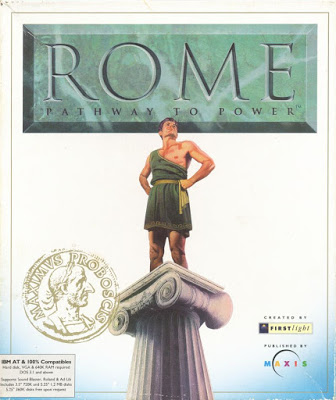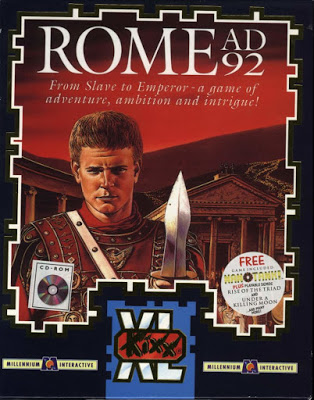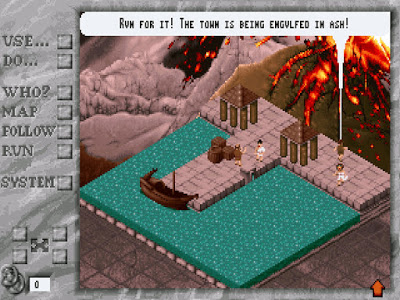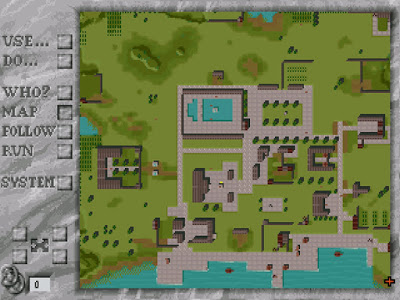From The Adventure Gamer
Written by Reiko
Rome: Pathway to Power is a bit of an odd duck. It’s a historical adventure set in Rome, of course, in AD 92, which was also its other sub-title. But its main screen uses an isometric perspective, and at least one level involves controlling whole armies rather than just one character. This quirkiness reminds me a bit of the Dune adventure game that I reviewed a year and a half ago, which was a hybrid adventure-strategy game. I hope Rome has as good a blend between the adventure and strategy aspects.
According to the official blurb: “Ancient Rome, AD92 – an era of ambition and political intrigue. You will take the part of Hector in this huge, role-playing adventure. Starting as a humble slave, you have the opportunity to fight your way to the top!” Apparently Hector wants to go all the way and become emperor. That’s going to be tricky for a slave.
 |
| The US cover for the game. |
 |
| The European re-release cover for the game. |
Millennium published Rome in Europe in 1992, first for the Amiga and then for DOS. But in the US, the game wasn’t published until 1993, by Maxis, a company much more famous for its later Sim games, especially SimCity 2000 (also from 1993). So there are at least two different versions of the box. Then the next year it was re-released in Europe by another publisher called Kixx XL.
 |
| The European re-release cover for the game. |
The primary designer was Stephen Grand, who designed the isometric interface used for Rome and Robin Hood. Later he designed and programmed the original bio simulation Creatures. I had trouble finding much about him until I started searching under “Steve Grand” (the programmer, not the country singer, of course). The documentation is credited to Ann Grand, who, I finally determined from his entry on the Creatures wiki of all places, was in fact his wife, but I get the distinct impression they divorced at some point, because nothing even close to recent mentions any family in relation to him.
 |
| Cover of Creation: Life and How to Make It |
Grand also has published a book called Creation: Life and How to Make It, which is about how he developed his creature AI. AI, especially the kind that learns, seems to be his specialty. I suspect some of his ideas were already being formed when he designed the behavior of the numerous NPCs in Rome as well. I’ll have to keep that in mind as I play.
Grand’s co-designer for both older games was Ian Saunter, who has a long resume of design and production credits spanning over a decade, including some of the Creatures games.
The developer is listed as a company called Firstlight, but I can find nothing about them now, as it’s too generic of a name. The isometric interface was apparently also used for The Adventures of Robin Hood, an action RPG previously published by Millennium Interactive in 1991. If we were covering RPGs, maybe Alex would have reviewed that one already.
 |
| The title screen of the game. |
I fired up the game in DOSBox and played the first few minutes of the game. The isometric interface is interesting, but it’s actually pretty difficult to control. Mostly Hector kind of roams around aimlessly until you tell him where to go, and then he meanders in that direction. Most people move around in real time too, which makes it hard to click on them to talk to them. The area of ground that’s visible is very small, too, and it doesn’t keep Hector centered.
 |
| The townspeople react to the volcano’s threat. |
Right away the pressure is put on the player when the nearby volcano begins erupting, and lava begins covering the map from the north. The docks are in the south, with someone who owns a boat offering places on it for three sesterces. But Hector is a slave and has no money. How will he escape!?
 |
| Map of the first level. |
There’s a map, but nothing’s labeled and I don’t know where anything is or even what’s useful, so I guess I’ll have to start out just wandering around and see what I can find, reloading if I run out of time and the lava engulfs the town.
Speaking of the town, it’s supposed to be Herculaneum in AD 92. However, any quick search will tell you that the eruption of Mt. Vesuvius that destroyed both Pompeii and Herculaneum happened in AD 79, so the game starts out right away being historically inaccurate by thirteen years. We’ll see how other historical aspects stack up.
If you want to play along, the game is available for download in multiple places and can be played online on the Internet Archive.
Note Regarding Spoilers and Companion Assist Points: There’s a set of rules regarding spoilers and companion assist points. Please read it here before making any comments that could be considered a spoiler in any way. The short of it is that no CAPs will be given for hints or spoilers given in advance of me requiring one. As this is an introduction post, it’s an opportunity for readers to bet 10 CAPs (only if they already have them) that I won’t be able to solve a puzzle without putting in an official Request for Assistance: remember to use ROT13 for betting. If you get it right, you will be rewarded with 50 CAPs in return. It’s also your chance to predict what the final rating will be for the game. Voters can predict whatever score they want, regardless of whether someone else has already chosen it. All correct (or nearest) votes will go into a draw.
Original URL: https://advgamer.blogspot.com/2019/02/game-105-rome-pathway-to-power.html

